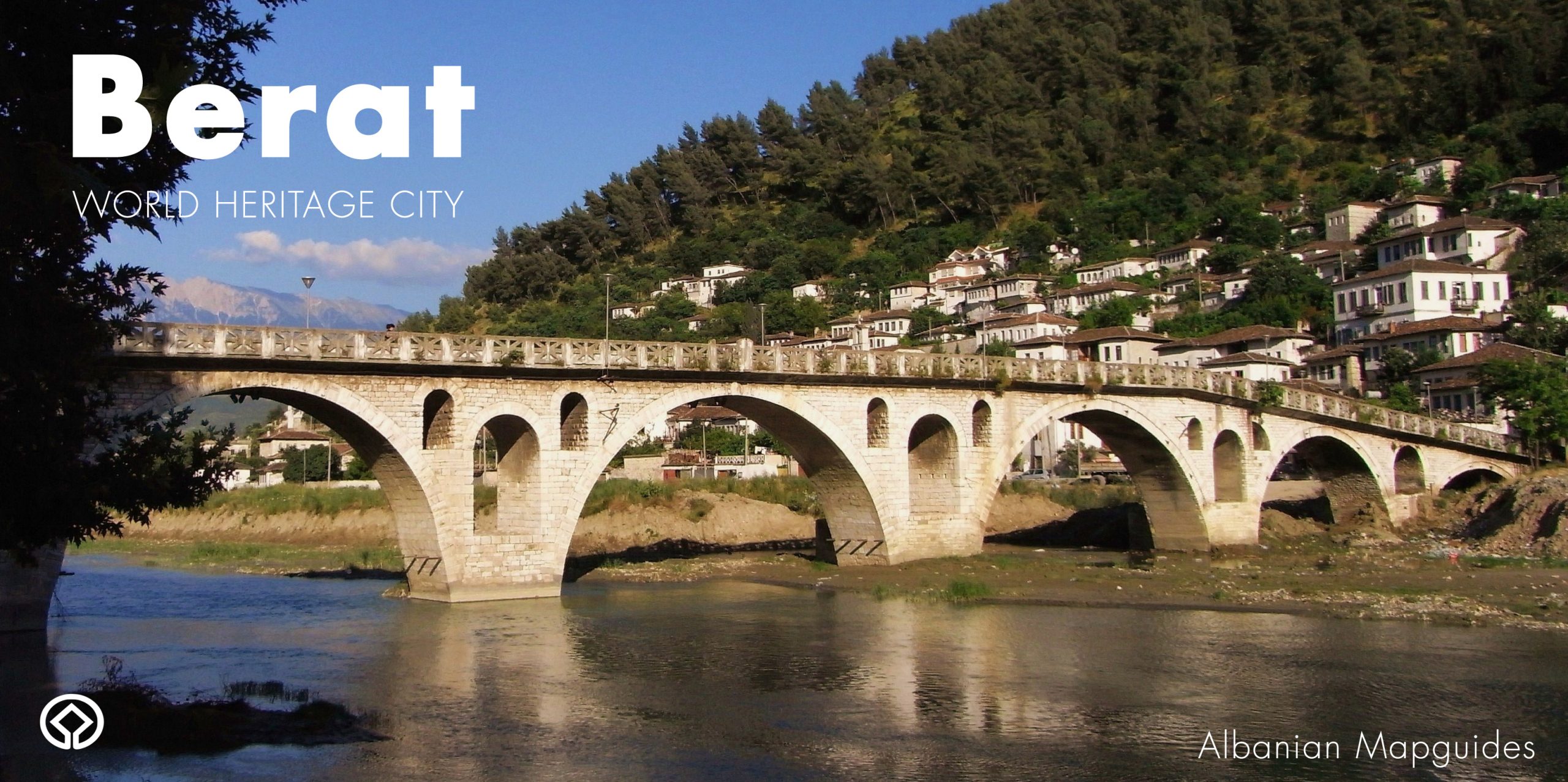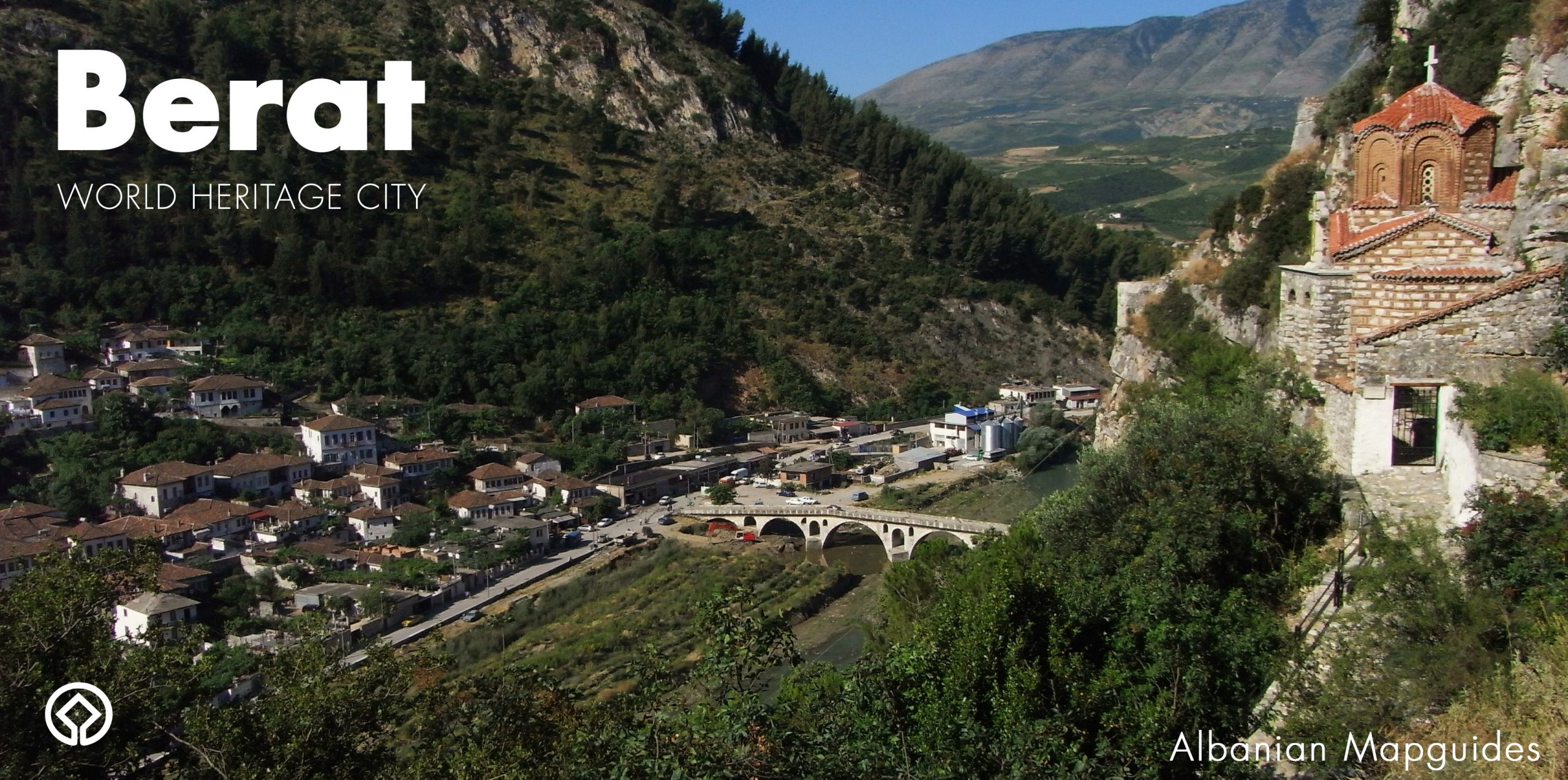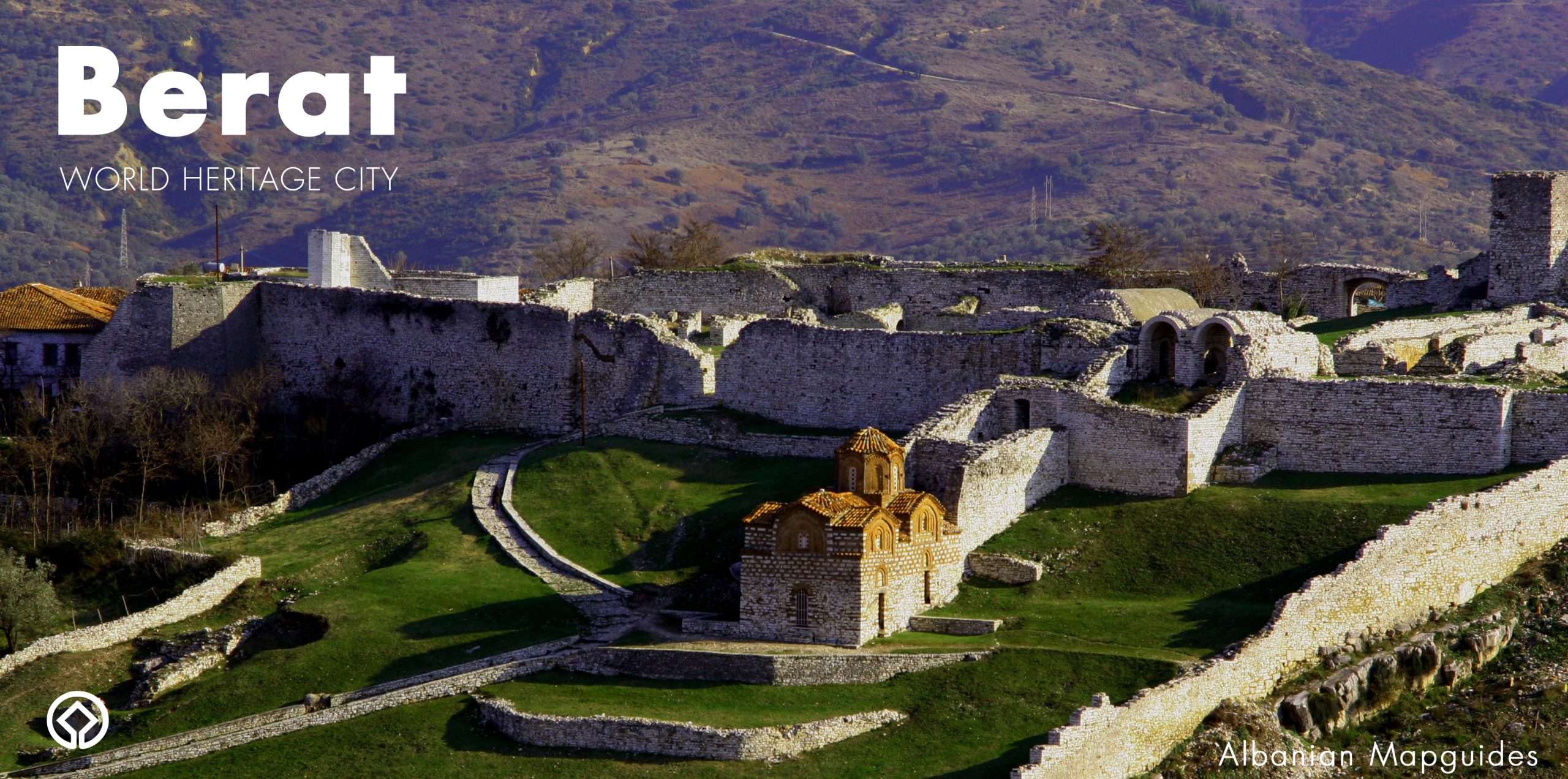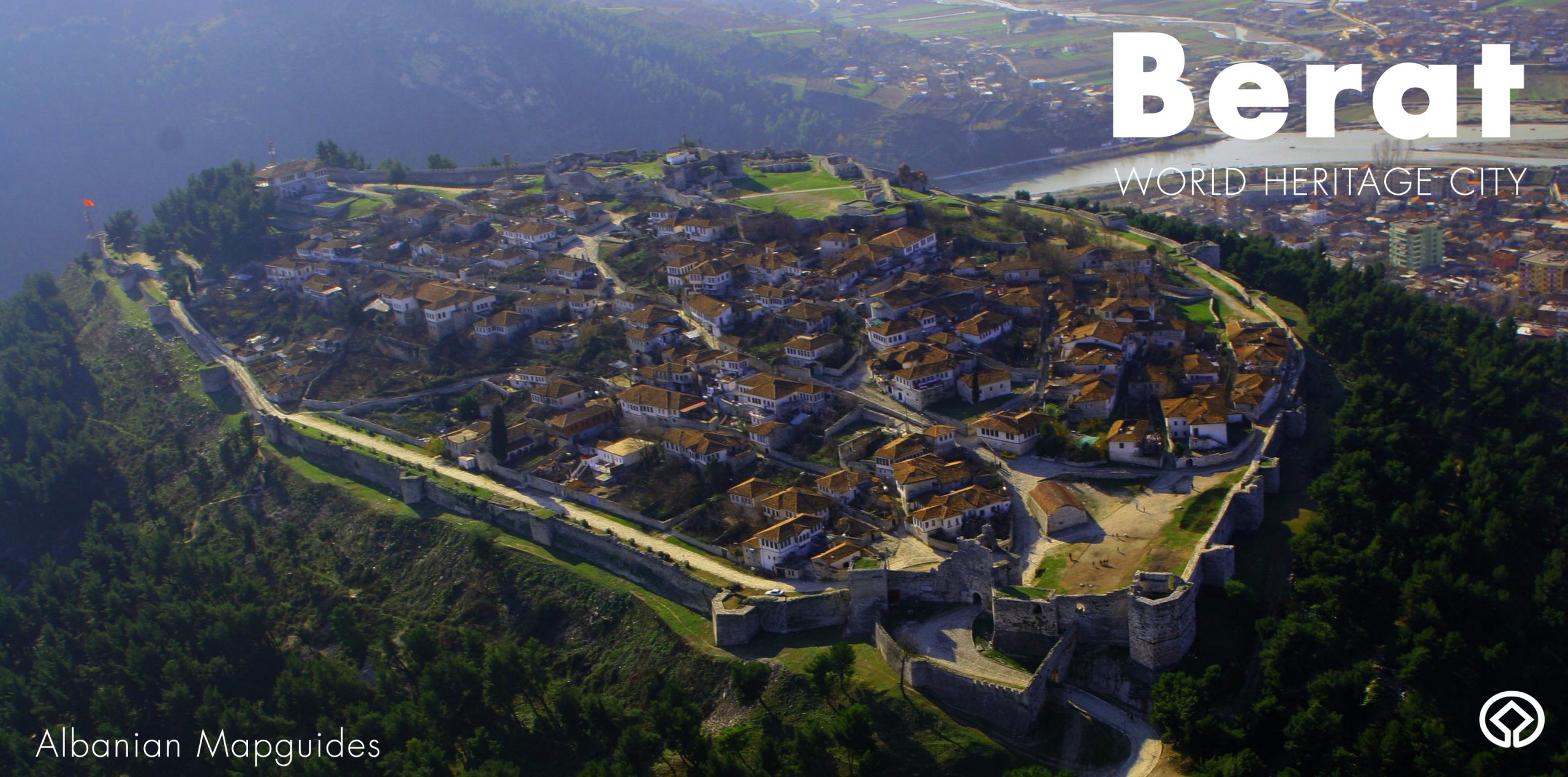MUNICIPALITY OF BERAT
Berat is a city with a century old history and the oldest city in the Republic of Albania with a pulation of 100,000 inhabitants. The city is the center of District of Berat. With the new administrative division, the Municipality of Berat includes within its administrative jurisdiction the city of Berat, the units Roshnik, Otllak, Velabisht and Sinje.
 It is located in the south of the country, 70 km south of Tirana, crossed by the Osum River and surrounded by hills and mountains. It has 455 m of altitude, while the city is at an altitude of 52 m above the sea level.
It is located in the south of the country, 70 km south of Tirana, crossed by the Osum River and surrounded by hills and mountains. It has 455 m of altitude, while the city is at an altitude of 52 m above the sea level.
Berat is known for its architecture, historical, cultural, artistic and religious values and It’s international cultural heritage center (traditional Mangalem neighborhoods, Gorica and the castle, the National Museum of Iconography “Onufri ‘” and other galleries, museums, churches, mosques). The 2,400-year history makes it one of the oldest cities in the country. It was declared “Museum City” in 1961 and currently part of the UNESCO list as a “World Cultural Heritage city”. Berat has been included in the UNESCO universal list since July 2008. In UNESCO it is registered as an extraordinary example of typical Ottoman architecture. At the eastern end of its territory, the municipality includes a part of Tomori National Park (2,416 m), while in the west includes Shpirag Mountain (1,218 m).
Berat has considerable number of monuments and with diverse values in terms of assets, which constitute a proof of cultural, historical and artistic heritage.
107 monuments of the first category and 383 of the second category, join the rare values of the nature of the landscapes that surround Berat, having in total 11 protected natural monuments, agribusiness products, eco-tourism attractions, rich cuisine, and above all the traditional hospitality.
Among the values, the most prominent are the Castle, built on a rocky hill in the shape of a triangle, with a perimeter of 1440 m, with 24 towers and two gates. With its Illyrian foundations, rebuilt several times in the VI, XIII, XV and XIX centuries, it is today not only one of the largest inhabited castles, but also a stone archive that offers a variety of styles and contributions of different eras: Illyrian, Roman-Byzantine, Albanian and Turkish.
The 7-arched bridge of Gorica, was built in 1780 entirely of stone. It is 129.3 m long, 5.3 m wide and rises 10 m above the Osum River.

The cult buildings include several capitols and colonnades and prove that in Berat there were Paleo-Christian churches of the IV-VI centuries (St. Todri). Among the most beautiful churches built in the XIII-XIV centuries are: St. Mary Vllaherna, St. Trinity and St. Michael. There are also a number of Islamic buildings in Berat, with outstanding architectural and artistic values. These churches, mosques, and other urban buildings, especially the ensembles of the Mangalem, Castle and Gorica neighborhoods, are pearls of medieval architecture.
The churches of Berat are decorated with Byzantine and post-Byzantine style paintings, created by various artists of the XII-XIV centuries and by masters of the XVI century: Onufri and his son, Nikola.
 St. Mary’s Cathedral is famous for its iconostasis, carved in gold-plated wood, a work of art of the highest quality.
St. Mary’s Cathedral is famous for its iconostasis, carved in gold-plated wood, a work of art of the highest quality.
A rare work has been found in Berat, the epitaph of Glavenica, a creation of 1373, embroidered in gold, silver and silk, depicting the crowned dead Christ, surrounded by Greek inscriptions.
The Purple Codex of Berat (World Memory) Classified by UNESCO in the “Memory of the World”, the Purple Codex of Berat dates back to the VI century and is written on purple parchment. It is one of the only four copies found worldwide. The second is the IX century Golden Codex (Codex Aureus), written on parchment in gold letters. Both of these codices contain portions of the Gospels written in ancient Greek. These codices were rediscovered in the castle in 1972 and are preserved today in the National Historical Museum in Tirana.
Berat also has a number of natural monuments to be visited, making it a unique ensemble of its kind. Berat during 2019 had about 150,000 foreign and domestic visitors but also during 2020, despite the impact of the pandemic on tourism, Berat remains one of the cities with the largest number of visitors.
Regional Attractions
Mountain Tomorri National Park- is the largest protected wildlife and outdoor recreation area. Visitors to the Park environs will find an abundance of nature’s gifts ripe for exploration and outdoor recreation.
Cascades of Bogove: The Cascades of Bogove are a light hike up from the village of Bogova. The trip along the riverbanks, takes approximately 45 minutes to reach the cascades and natural springs. The cascades of Bogova are the region primarily source for fresh drinking water. Hidden in the cool shade of the forest of the foot of Mountain Tomorri , the cascades offer a popular retreat from the summer heat of the region. The village of Bogove is about an hour ride from Berat.
Canyons of Osumi: The canyons of Osumi are standing evidence of the active geological history in the area and mainly trails and areas for outdoor recreation.
The region around the city typically has a Mediterranean climate, though given the topographic variation there are diverse microclimates as well, including alpine. The driest month is July and the wettest months are November and December. The micro-climates immediately around the city are very favourable for farming, and thus development of local agribusinesses is seen as very important for the city’s economic development.
Berat’s available human resources now position the city as an important source of economic development for Albania as a whole. The majority of the population is of working age and the presence of a large population of youth. The city has a population of 100.000 inhabitants.
Municipal government
The Municipality of Berat forms part of the district with the same name and is the centre of the Berat Region. The Municipal Council, as the decision-making organ of municipal government, has 31 members, which were last elected in July 2019. The Mayor of Berat is Mr. Ervin Demo and is elected directly by the voters. After the territorial reform, the New Municipality of Berat was enlarged with a surface of 384 km2 and with 50 surrounding villages.
Municipal budget
The main sources of income for the municipality are budgeted by both central and local government; the former is very important and is divided into conditioned and unconditioned funding. The local government has, in addition to the investments made to improve the city infrastructure, made a special priority for the use of its revenues for the direct benefit of its citizens through direct services offered to the community.
Main advantages of Berat municipality
Berat has a favourable geographic position for installation of a modern, complete infrastructure. Its location, flora and fauna, and its unique architecture and artefacts make the city attractive for tourists and appropriate for the development of a good quality of life for its citizens. The economy of the city is focused in three directions: Infrastructure, tourism and services.
 The big producing and manufacturing businesses, of light and food industries are developed by exploiting the resources of the region. The most part of the small businesses deal with ambulant trade and services. In the city operate 1496 businesses. Production and services are the two main pillars of the economy. 40% of the products circulate inside the Country, the remaining good are for export.
The big producing and manufacturing businesses, of light and food industries are developed by exploiting the resources of the region. The most part of the small businesses deal with ambulant trade and services. In the city operate 1496 businesses. Production and services are the two main pillars of the economy. 40% of the products circulate inside the Country, the remaining good are for export.
There are many other active businesses in Berat, including the industries that deal with food products, meat and alchoolic and nonalchoolic drinks. Some manufacturing industries are attracting investments. They are the light industry, construction materials woodwork etc.
There is an increase in the industry of stone manufacture, by exploiting the natural resources of the Tomori region for construction materials and decorative stones. In the inner market these materials are substituting to a certain extent the exported materials and are present in the international market as well.
The region has a typical Mediterranean climate, which makes it possible to develop agriculture as an important foundation for development of agribusiness. The total surface area of nearly 23 km2, of which about 6 km2 are urban and nearly 2 km2 are agricultural land, supports the idea of developing local agriculture. In addition, the farm irrigation system is still functioning, so that one important part of farming infrastructure is already in place.
Agro-business is a promising sector for the future development of Berat which is reflected in the number (41) of operating businesses in this field. The total territory that they cover is 23.5% of the total surface area, the number of employed people in this sector is 42.3% of the total employment and they make 49% of the total number of businesses.
The Uznova district of Berat is the municipality’s newest administrative division and includes a considerable amount of agricultural land. It provides many possibilities for development of agriculture, with farming enhanced because of the proximity of villages and communes to the city.
Furthermore, certain agricultural products such as olives, figs and cherries have been cultivated in Berat for thousands of years. Today they cover about 13% of the agricultural land of Berat.
At the moment the agro-business industry in Berat uses still the local agricultural products. The export of these products forms a considerable part of the total export of the District.
Berat is home to numerous museums and cultural artefacts, which together have a unique value, making the city attractive for both local and foreign tourists. There are some 108 cultural monuments in the city, and the Mangalem district is home to a unique complex of museums of remarkable architecture. The district of ‘one thousand windows’ has one thousand and one possibilities for foreign, national and local tourists. The Castle district has many important cultural objects, including, since 1961, the Onufri Museum, while the district’s unique architecture has attracted the attention of both local and foreign researchers. The Gorice district is another museum complex, again of architectural importance, forming part of the natural and historical wealth of the city that attracts local and foreign visitors alike.

The population of the city is relatively young, with an average age of 28 years and with a life expectancy of 70 years. Thus, it has a young, willing workforce, which, given the importance and quality of education in Berat, is also well qualified. Improving further both professional and general education, to deal with certain gaps, would improve the qualifications of that workforce.
Continuous improvement of municipal services and infrastructure is an important feature that opens a new prospective for the future economic development of Berat, while the favorable situation concerning law and order provides a secure investment environment for business.
Around the city, there is adequate space for enhanced concentration of businesses within the existing industrial zone and for improvement of the battery plant area in order to make it an important site for development of agribusiness. The zone’s location makes it a suitable area for establishing an agribusiness wholesale market.
The distances to Berat from the country’s seaports, airports and other cities are not substantial and make communication easy.
Partnerships and networks
The city of Berat in July 2007 becomes part of the Network of Balkan Towns with historic centers. After, the network has applied for EU funds for joint projects. This has been a very fruitful experience for us, because part of the network are EU countries, and we have had the possibility not only to apply for the EU funds, but also to share the experiences in detail for the standards of the preparation and implementation of the projects.
In 2010 –Berat becomes part of the World Heritage Cities Organization and is presented in the whole packages in and having the possibility to be promoted.
In addition, in September 2010, Berat became a member of the European Cities of Culture and Art Network – with an invitation from the French Association of the cities of Art and Culture.
Berat is also a member of the NALAS network (Local Authorities of South-eastern Europe).
POINTS OF INTEREST
- Museums:
‘’Onufri ‘’ -National Museum of Icons – located within the old Cathedral of Dormition of St. Mary (18th century) which is a Byzantine style Church characterized by a marvelous golden wooden iconostasis. The collection of the icons dating back to the 14th – 19th centuries include important works by the great artist Onufri and his school of painters.
Ethnographic Museum – Placed in one of the best-preserved traditional houses of Berat which dates back to the 18th century. Inside there is the archaeological pavilion, an imitation of a medieval bazaar, the architectural pavilion and the environments of a typical house of the 18th century.
- Art Gallery ‘’Edward Lear’’ – Opened in 1994 is one of the most important and best Art Galleries in the country. The collection highlights many contemporary and past art works by the artists from the country and abroad.
Historic sites:
- CASTLE:

- Cathedral of Dormition of Saint Mary (‘’Onufri’’ National Museum of the Icons). see the descprition above.
- Church of Saint Mary Vlaherna- Saint Maria Vlaherna church is the oldest one still existing in Berat city (13th century). This church has been recovered in the 16th century and its frescos are painted by artist Nicola, son of Onufri.
- Church of Saint Nicola (16th century) –The archaeological excavations have found that the walls of this church were built in the 16th Inside the church is found a capitol used for the rituals which is an element of the Paleo- Christian architecture.
- Church of Saints Constantine & Helen –The church is a chapel which was completed in the year 1644. It has a ceiling with the decorative elements and its frescos present scenes from the crucifixion of the Jesus.
- Church of the Holy Trinity – (13th– 14th century) . The church was built closed to the second surroundings walls in the Castle. It has beautiful Byzantine murals, and its walls were built using the cloisonné technique.
- Acropolis –Placed in the higher part of the Castle, it is surrounded by the second perimeter of the walls in the Castle. Inside it are found the ruins of the houses of the Turkish military garrisons, the ruins of the White Mosque built in the Ottoman period and the remains of the Feudal Chamber.
- Water cistern- (13th– 14th century). It was used for the conservation of the water during the late Middle ages. A stone tunnel was built in the southern side to bring the water from the river directly to the tower.
- Red Mosque-( 15th century) –The mosque is one of the oldest in Albania. At the beginning it served to the caravans coming from East to West and later it served to the Turkish garrisons.
- Church of Saint Demetrius – The church has been rebuilt over the ruins of an older chapel in the 16th -17th According to an epigraphy the church has been painted in the year 1607.
- Church of Saint Theodore (16th century) – The church was built in the middle of the 16th century and was painted by Onufri. Inside the church of St. Theodor was found the copy of the Epitaph of Gllavenica, an outstanding art work of the year 1373 .
- Church of Saint Elijah – This church is located outside of the surrounding walls of the Castle. The biblical scenes in this church are written in Albanian language, a rare sample in religious objects in Berat. During the communist regime this object was destroyed and was rebuilt after the 1990’s.
- GORICA:
- Monastery of St. Spiridon (18th century) – The monastery of Saint Spiridon is placed in the center of Gorica quarter. The epigraphy in its entrance dates the object back to the year 1864. The monastery’s building represents a typical scheme of the basilicas of the 18th
- Thomas’s Church (18th century) – The church of St. Thomas is located in Gorica quarter. The object was destroyed during the communist regime and was rebuilt after the 1990’s with the donations given by the Christian community of the city of Berat.
- Ruins of Gorica Castle – Gorica Castle has been another castle in the city that belongs to the same period with the Castle positioned in the opposite hill. Today are found only the ruins of this castle.
- Gorica Bridge- The wooden bridge of Gorica was built in 1780 by Ahmet Kurt Pasha It was rebuilt two times ; in the 18th century it was recovered in stones and during the years 1920- 1930. The churches of Gorica are opened every day for the visitors (free entrance)
- MANGALEM:
- Bachelor’s Mosque – Built in 1827 with the aim to serve to the bachelor craftsmen in the city. Characteristic for this mosque is the application in its facades of the paintings representing the scenes from the city.
- Michael’s Church – (13th century)-Built on the pointed rock in Mangalem quarter demonstrates a mastery of the cloisonné technique. Compared to other churches of Berat, in this church is found a higher architectonic level and a tendency for a perfection of the forms.
- MEDIEVAL CENTER:
- King’s Mosque (15th century) The King Mosque is one of the most important Mosques in the city. It is part of the Islamic Center and was built at the end of the 15th century by Sultan Bajaziti II .
- Teke of Helveti- (15th century) The Teke of Helveti was built in the 15th century and rebuilt by Ahmet Kurt Pasha in Characteristic for this Teke is the wooden ceiling decorated according to baroque style adapted to the Islamic art with the paintings described as the most beautiful of that time. To enter in these objects please ask in the building next to Helveti’s Teke –(Directory of the Culture Monuments )
- Other points:
- New Orthodox Church (opened every day for the visitors)- The church of Saint Demetrius – built in 2006 in the existing place of the Old Cathedral of the town.
- Leaden Mosque – (16th) The most beautiful mosque built during the domination of the Sultan Suljeman Konunor (1520-1566) , a period in which the city was becoming an important center under the Ottoman Empire. This is the biggest mosque of this type in Albania.
This webpage has been produced with the financial assistance of the European Union. The contents of the webpage are the sole responsibility of University of Western Macedonia and can, in no way, be taken to reflect the views of the European Union, the participating countries or the Managing Authority


